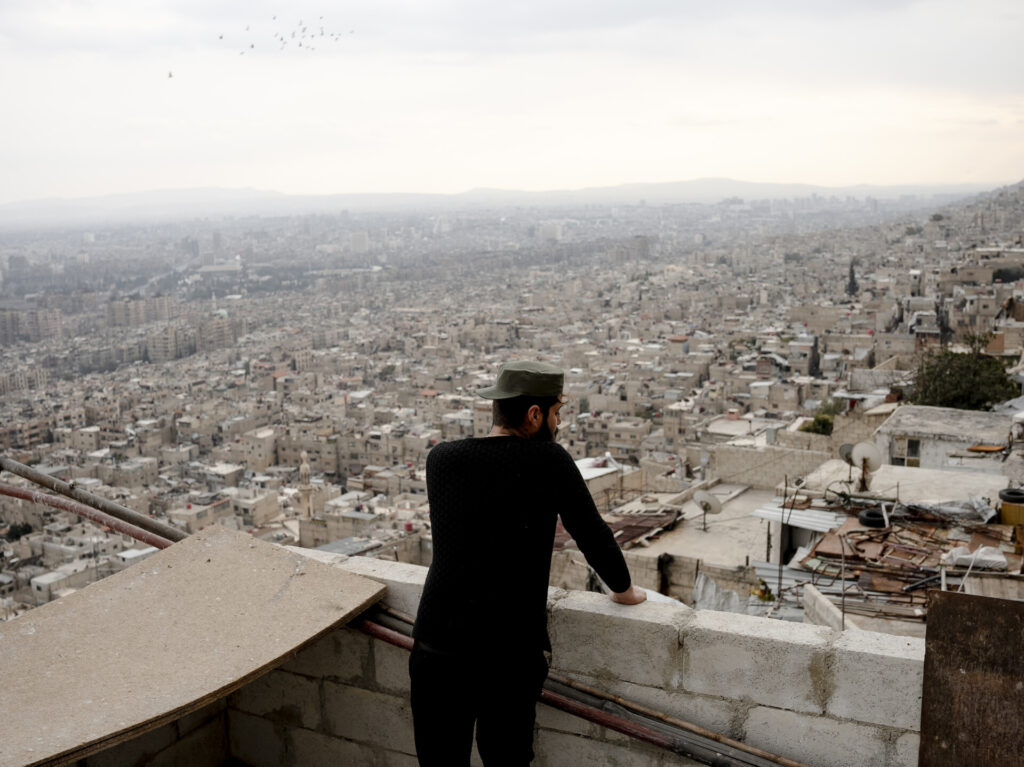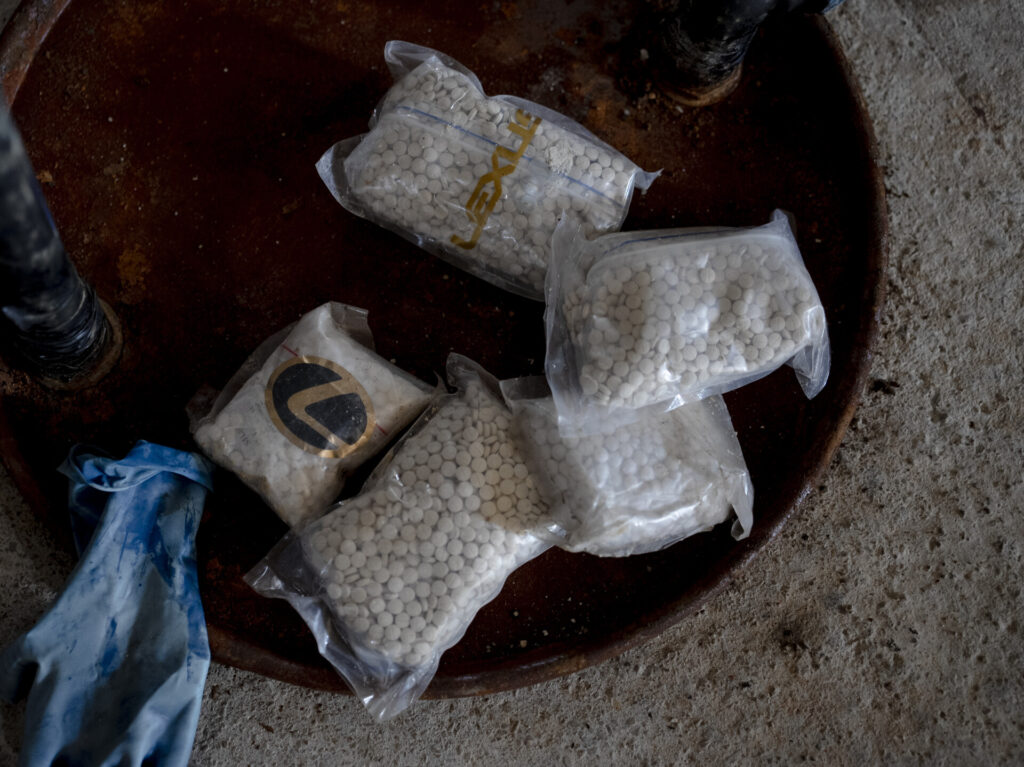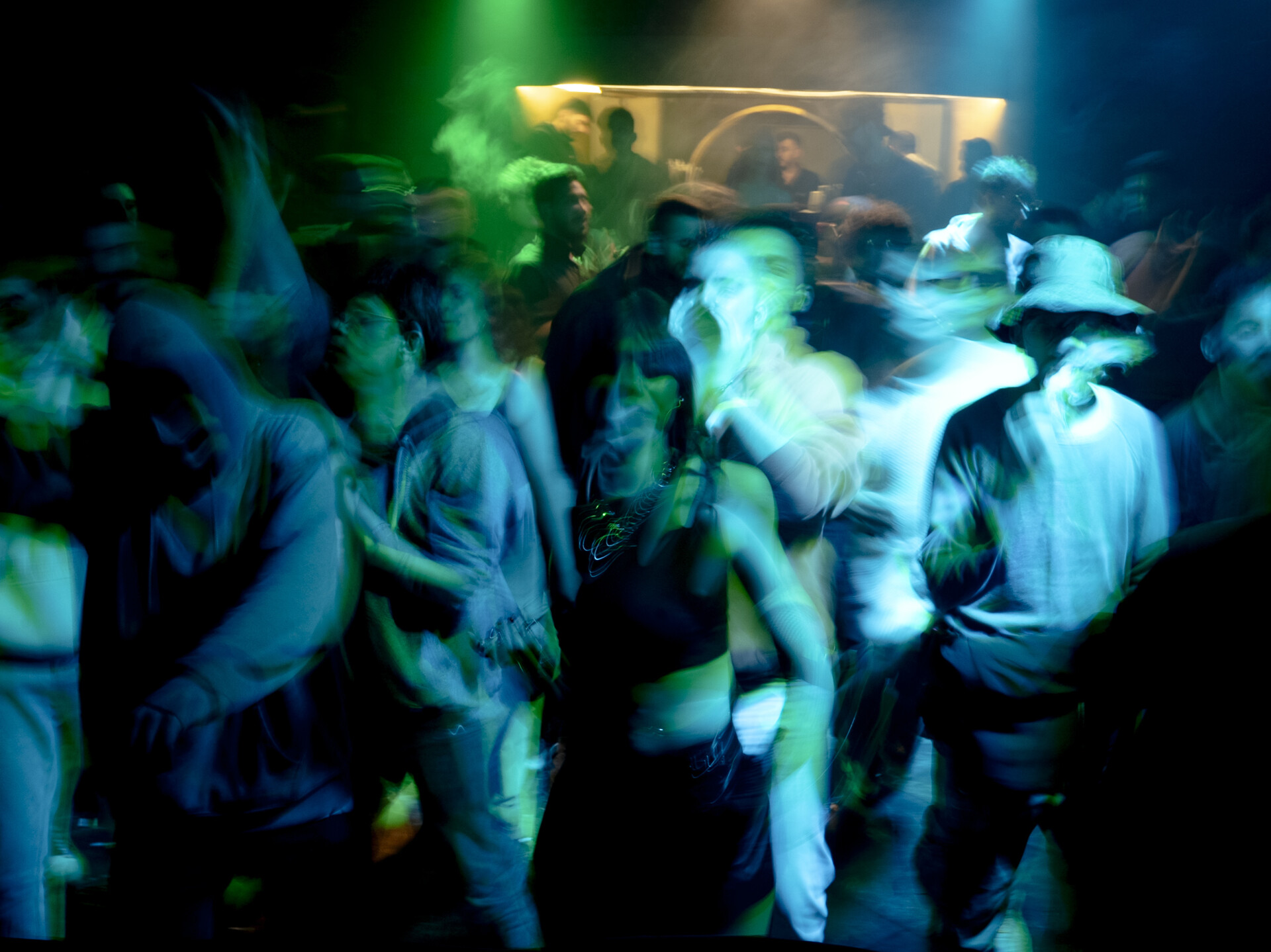In the dimly lit basement of a Damascus hotel, the bass line of techno music echoes through the air, as dozens of young Syrians sway in rhythm, far from the political turmoil outside. Amid the pulsating beats, small white pills of Captagon — an inexpensive, amphetamine-type stimulant that has become synonymous with Syria’s illicit drug trade — are circulating freely, a stark reminder of the legacy of former President Bashar al-Assad’s narco-state, four months after his regime’s fall.
Once dubbed the “jihadists’ drug” for its alleged use by fighters during Syria’s civil war, Captagon has infiltrated every level of society, becoming a staple among Damascus’ privileged partygoers.
“Everyone here takes it,” says Hassan, 32, as he reveals a small plastic tube filled with pills (names in this essay have been changed to preserve anonymity). “There’s been no shortage since the fall of the regime. My dealer still has everything in stock, and the price hasn’t changed — 50 cents to $1 per pill.”
Under Assad’s rule, drug-fueled parties were often shielded by powerful connections. Raves hosted by figures like Assad’s nephew Bassel Shawkat were secured by regime loyalists moonlighting as nightclub bouncers, creating safe havens for both consumption and distribution.
But Syria’s new rulers, emerging from factions that once controlled opposition strongholds like Idlib, have declared war on the drug trade that thrived under Assad’s regime.
“We still use drugs, but it’s riskier now. The new authorities are stricter — if you get caught, it’s not as easy to get away with it as before,” Hassan adds.
“A few years ago, there was Captagon and trafficking in Idlib,” says Abu Amin, a member of Hayat Tahrir al-Sham (HTS), the rebel group that spearheaded the campaign that led to Assad’s downfall. “But our antidrug policy was strict — life sentences for traffickers.” HTS has carried its hard-line stance into its governance of post-Assad Syria, vowing to dismantle the drug networks.

In New Sham, an upper-class northwestern suburb of Damascus, a rehabilitated antidrug center now bears the freshly painted emblem of Syria’s revolutionary flag — a symbolic rebirth for a facility once entangled in the regime’s illicit networks. Part of the new unit is a balding 40-year-old guard, tasked with dismantling the remnants of a system that transformed Syria into a global narco-state under Assad.
“When we arrived, there were drugs everywhere — Captagon stacked to the ceiling. But this place was a fraud. The regime arrested dealers only to confiscate their stock and sell it to others, profiting twice,” says Abu Amin, who is a member of the new antidrug task force.
For years, Syria was a linchpin in the global Captagon trade. Under Assad’s brother Maher and his notorious 4th Division, Captagon production became a multibillion-dollar enterprise tied to the regime’s inner circle.
One of his military plots, which also served as a covert Captagon production hub, is located just 300 meters from the antidrug center.
The regime’s grip extended to neighborhood kiosks, known as kesheks, where small vendors sold drugs under the watchful eye of the intelligence services. “Every kiosk in New Sham sold drugs,” says Mansour, a local resident. “They all worked with the regime. When the old system collapsed, many owners fled.”
“The regime encouraged the use of Captagon. Young people addicted to drugs didn’t represent any danger, they were depoliticized and didn’t challenge the government,” adds Mansour, some of whose friends fell into the drugs trap.
“Young people were lured into selling drugs to afford motorcycles or nights out with girlfriends. It was a way to control the population,” says Abu Shadi, a vegetable vendor in the Rukn al-Din neighborhood.
In this district clinging to Mount Qasioun’s slopes in northeastern Damascus, residents recall how the regime weaponized vulnerability and forcibly flooded the neighborhood with the “poor man’s cocaine.”
“Policemen stopped me in the street, searched me and slipped drugs into my jacket,” recalls Hamza, a young local. “I had to pay them off. Those who couldn’t afford it were forced to work for them.” The practice was common, according to young people interviewed for this essay.
“The neighborhood became a jungle for its residents but a ‘perfect garden’ for the Assad family’s drug empire,” says Yahya Daher, a shopkeeper who says he now feels safer under the new authorities.
Abu Shadi says he witnessed firsthand how Hezbollah, the Lebanese militia, and Syrian army volunteers facilitated trafficking during the war. “They handed out sachets containing 50 to 70 pills to young fighters on the front lines,” he says. “Some took the pills, others would sell them back home. Many war crimes were committed by people under the influence of these substances.”
The consequences of this drug-fueled strategy linger today. Ghandy Farah, director of the Ibn Rushd public hospital in Damascus, says the country lacks addiction treatment infrastructure. “We have only 40 beds for addicts in need,” he says. “And Captagon is a springboard for other drugs, stronger, more dangerous, more addictive.” For many young Syrians, prison has become an unintended substitute for rehabilitation.
“People use and sell drugs for economic reasons. Unemployment is high, so we’re trying to find work for the drug dealers. We’re targeting young people in particular, and despite the limited resources we have, we’re trying to develop sports activities and a medical and social center,” says Gen. Bassam, head of the Rukn al-Din reconciliation council. Made up of former revolutionaries, this new committee is determined to curb drug addiction. “We’ve seen a 60% to 70% drop in consumption here since [Assad’s] fall,” he claims optimistically. “For many young people, there is renewed hope.”

Yet, in the heights of the district, Hamza and his friends remain skeptical: “Nothing has changed. Dealers are still on the streets after 8 p.m., selling Captagon or hashish without interference from security forces.”
In Syria’s western borderlands, near Lebanon, Mahmoud Abdelkader, the leader of a unit patrolling the border, points to buildings dotting the valley. “Every building you see is a Captagon production plant,” he says. These small, warehouse-like structures, some freshly built, are located less than a mile from the Lebanese border.
The region, once controlled by Hezbollah, served as a critical hub for Assad’s narco-economy. The road leading to the Lebanese mountains still bears traces of this legacy: A tattered yellow Hezbollah flag hangs from a tree near a former checkpoint.
“From here to the border, this entire area was under Hezbollah’s control,” says Abdelkader, gesturing toward the rolling hills of Wadi Hanna.
The strategic corridor was fiercely contested. In early February, HTS forces, now part of Syria’s new governing coalition, launched an offensive to reclaim this territory west of Homs. The residue of the battle is stark — a charred Syrian tank lies abandoned on the roadside, destroyed by a Hezbollah anti-tank missile.
“The fighting lasted over 10 days,” recounts one soldier, his face hidden by a scarf. “The militias retreated to the top of the mountains and bombarded us with mortars and rocket launchers.”
In one drug farm abandoned following HTS’s offensive, the remnants of this illicit trade remain scattered across the floor: sachets of Captagon pills marked with logos denoting their quality — two crescents for premium-grade “al-hilalain” (“two crescents”) and Lexus car symbols for mid-tier batches. Nearby, cans reeking of acetone, a key ingredient in Captagon production, sit half-opened amid heaps of scales and account books.

The new authorities in Damascus have vowed to dismantle these operations as part of their broader campaign to root out corruption and criminality left behind by Assad’s regime. Yet the scale of the challenge is immense. The narco-economy that flourished under Assad and Hezbollah remains deeply entrenched in Syria’s borderlands, where decades of war have created fertile ground for outlawed industries to thrive.
Overlooking Wadi Hanna, the village of Akkum, perched near the Lebanese border, has long endured the effects of Syria’s narco-state. “We lived with the toxic smell of the valley’s factories on a daily basis,” says Souad Saad, a resident of Akkum.
For years, villagers watched as jeeps and trucks, often covered with tarpaulins, rolled into the area’s clandestine drug factories. “Higher up were other factories run by the 4th Division. We couldn’t say anything; we had to stay away from their activities,” she adds.
The fall of Assad brought hope to Akkum’s residents, but fear quickly followed. Traffickers and Lebanese militias remain active in the region, prompting locals to demand stronger military protection from Syria’s new authorities. “In these mountains, we’re always surrounded by traffickers,” says Zehreddine Saad, 27, who received threats after posting a photo of a militia leader on Facebook. Audio recordings sent to his phone vow revenge against those who oppose the traffickers’ return.
Efforts to secure the border are underway. “Most border crossings have been closed to disrupt smuggling routes,” says Abdelkader.
Flying overhead is a Shaheen drone, designed by former rebels in Idlib, scanning for smugglers in the rugged terrain. Syrian forces have even briefly crossed into Lebanon to pursue fleeing militia members before retreating, allowing the Lebanese army to reclaim areas it had not controlled in 14 years.
Despite these efforts, the challenges remain daunting. “There are hundreds of tracks coming from Lebanon; it’s very difficult to control everything,” admits Abdelkader. His small unit lacks the manpower needed to patrol the 230-mile border effectively. Just days earlier, Syrian forces dismantled an active Captagon factory in Serghaya, further south.
For Hezbollah, Assad’s fall represents a significant blow, not only politically but also economically. The group had relied on smuggling routes through Syria’s Homs and Palmyra to connect with allies in Iraq and Iran. Much of the drug was destined for Gulf markets like Saudi Arabia, hidden in various objects.
These routes carried more than drugs; they also transported weapons and missiles into Lebanon. “This route of Wadi Hanna was crucial for Hezbollah,” says Abu Jaafar, a farmer from al-Aqrabiyah, a Shiite-majority Syrian town near the border where Lebanese drug lords like Nouh Zaiter operated freely under Assad.
Captagon production was one of the pillars of Syria’s economy under Assad, earning an estimated $6 billion annually by 2024 — nearly 80% of global production, according to United Nations estimates. Now, the new Damascus authorities, still under international economic sanctions, will have to find a way to compensate for this considerable financial loss.
“Spotlight” is a newsletter about underreported cultural trends and news from around the world, emailed to subscribers twice a week. Sign up here.



